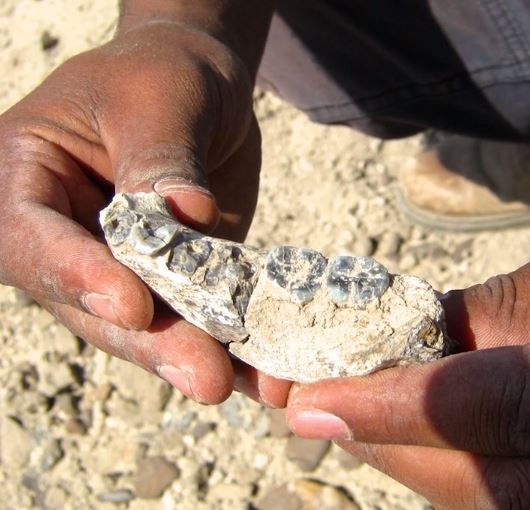The human genus Homo existed 2.8 million years ago, about 400,000 years earlier than previously thought, after a fossil of a lower jaw with five teeth was found in the Ledi-Geraru research area at Afar Regional State in Ethiopia, an international team of geoscientists and anthropologists informed.
Homo is the genus of hominids (primates) that includes modern humans and species closely related to them.
Two reports, describing this amazing find, have been published in the academic journal Science (citations below).
This jaw, discovered in 2013 by a team of researchers led by Kaye E. Reed, Christopher J. Campisano and J Ramón Arrowsmith from the Arizona State University, and Brian A. Villmoare of the University of Nevada, predates the fossils of ancient humans by about 400,000 years.

The small molars suggest this 2.8 million-year-old fossil is from an early human. (Image: Science)
For several years, scientists have been looking for African fossils documenting the earliest phases of the Homo lineage. The problem has been finding specimens recovered from the critical interval between 2.5 million and 3 million years ago. The very few recovered ones have been poorly preserved.
Erin N. DiMaggio, research associate in the department of geosciences, Penn State, said:
“The record of hominin evolution between 3 and 2.5 million years ago is poorly documented in surface outcrops, particularly in Afar, Ethiopia.”
Consequently, nobody has been able to agree precisely when the Homo lineage evolved into modern humans.
This latest 2.8 million-year-old fossil provides clues to changes in the teeth and jaw in Homo only 200,000 years after the last known occurrence of Australopithecus afarensis (“Lucy”) from the Hadar site, also in Ethiopia.
Team leader, Prof. Villmoare told the BBC that Lucy’s kind probably evolved into the very first primitive humans.

Lucy’s kind – Australopithecus afarensis – probably evolved into the first primitive humans. (Image: Wikipedia)
The fossil’s back molar teeth are smaller than those of other ancient humans that lived in the area. Humans have smaller molars than their more primitive ancestors, said Professor William Kimbel, director of the Institute of Human Origins at Arizona State University.
Prof. Kimbel told the BBC:
“Previously, the oldest fossil attributed to the genus Homo was an upper jaw from Hadar, Ethiopia, dated to 2.35m years ago.”
“So this new discovery pushes the human line back by 400,000 years or so, very close to its likely (pre-human) ancestor. Its mix of primitive and advanced features makes the Ledi jaw a good transitional form between (Lucy) and later humans.”
The researchers say that climate could have been the catalyst that drove the transition from tree dweller to upright walker.
Professor Kaye E. Reed, from the Institute of Human Origins at Arizona State University, said:
“We can see the 2.8 million-year-old aridity signal in the Ledi-Geraru faunal community. But it’s still too soon to say that this means climate change is responsible for the origin of Homo. We need a larger sample of hominin fossils and that’s why we continue to come to the Ledi-Geraru area to search.”
Hominins are the group of primates which include Homo sapiens (humans) and their ancestors. The term is used for the branch of the human evolutionary line that has existed since the split from chimpanzees.
Two Citations:
“Early Homo at 2.8 Ma from Ledi-Geraru, Afar, Ethiopia,” Brian Villmoare, William H. Kimbel, Chalachew Seyoum, Christopher J. Campisano, Erin DiMaggio, John Rowan, David R. Braun, J. Ramon Arrowsmith, and Kaye E. Reed. Science aaa1343. Published online 4 March, 2015 [DOI:10.1126/science.aaa1343].
“Late Pliocene fossiliferous sedimentary record and the environmental context of early Homo from Afar, Ethiopia,” Erin N. DiMaggio, Christopher J. Campisano, John Rowan, Guillaume Dupont-Nivet, Alan L. Deino, Faysal Bibi, Margaret E. Lewis, Antoine Souron, Lars Werdelin, Kaye E. Reed, and J. Ramón Arrowsmith. Science aaa1415. Published online 4 March, 2015 [DOI:10.1126/science.aaa1415].
Video – Institute of Human Origins Discovery
